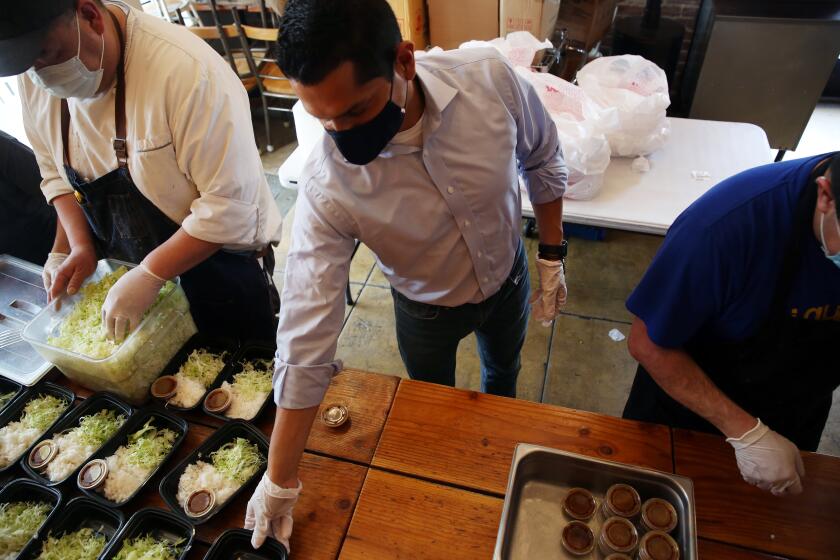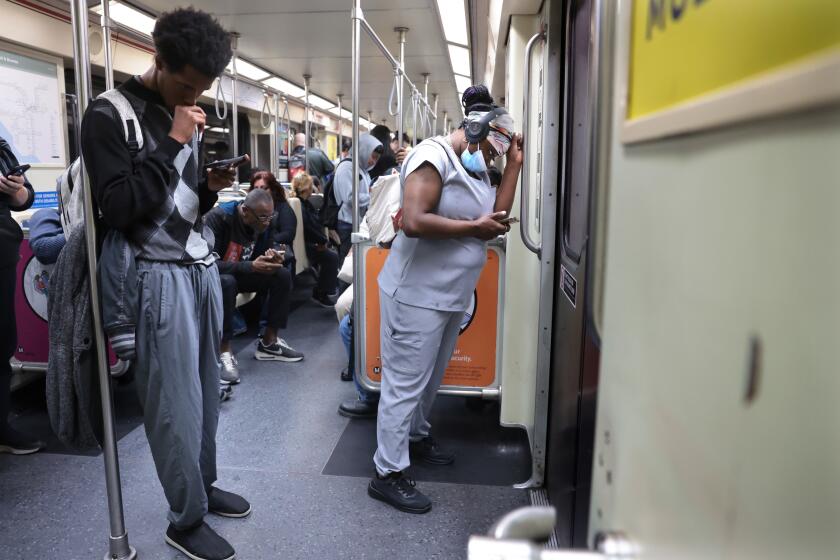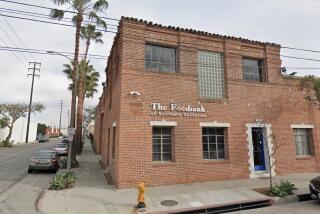Pandemic-era meal delivery program is set to end. Thousands of L.A. seniors could go hungry

- Share via
Tim Icely did everything he was supposed to do to save up for retirement. He worked 27 years in hospitality and hotel management before he was furloughed during the pandemic and forced to retire at 74.
Icely is now 76, single with no dependents and no spouse, living on his own in Van Nuys. Half of his Social Security check goes toward rent, and sometimes it feels as though he’s tiptoeing on the edge of disaster.
“I’m too rich for most of these [poverty] programs,” said Icely, who doesn’t qualify for CalFresh, California’s food stamps.
But Icely has kept hunger at bay thanks to five free meals he gets at the start of each week through Los Angeles’ Rapid Response Senior Meals Program, an effort launched during the pandemic to help low-income and homebound seniors. The home-delivered meals supplement his diet at a time when skyrocketing inflation is ballooning his grocery budget to $200 a month.
Icely is one of 5,800 seniors at risk of losing this food resource because the program is scheduled to expire this fall and the city may be hard-pressed to extend it because of a looming budget deficit. The program, which was first authorized last year with an $11-million budget, can continue if the City Council can find funding to extend it.
“It’s imperative that the city ensures that our vulnerable seniors do not go hungry,” Councilmember Heather Hutt said in a statement. Hutt proposed a motion to the council’s Budget, Finance and Innovation Committee to reallocate $8 million from budget reserves to extend this program through the next fiscal year.
Low-income seniors who struggle to leave the house face hunger and health issues.
The chair of the committee, Councilmember Bob Blumenfield, responded by asking the city Department of Aging to evaluate the status of the program, the eligibility requirements, other forms of funding and alternative meal programs.
This program “was created during COVID to help get meals to people in isolation. It was never meant to continue in perpetuity,” Blumenfield’s communications director, Jake Flynn, said by email.
Food meal delivery programs were effective during the pandemic, said Kayla de la Haye, director of USC’s Institute for Food System Equity. Food insecurity among seniors didn’t spike as it did among young adults, she said. And she attributes that to the city’s “targeted, effective programs for the seniors like home delivery of food that got scaled up so quickly” during stay-at-home orders.
As pandemic restrictions have lifted, she said, it’s become less ideal for L.A. to pay for these types of services.
“There’s downsides to home delivery of food, and social isolation is one of them,” said De la Haye. Studies have shown that loneliness among seniors can lead to adverse health risks. Then there’s the matter of cost, she said, noting that it’s cheaper to serve meals in group settings.
In a report from City Administrative Officer Matt Szabo, he advised against continuing the program because of budget constraints. It costs the city about $9.20 per meal to reimburse contractors such as Revolution Foods and Everytable.
Thousands rally against Wal-Mart in Chinatown
But De la Haye does not support removing programs such as Rapid Response Senior Meals. She said they can be effective in addressing the hidden food insecurity of seniors who can’t leave their homes and face greater risk in crowded markets and eateries as new COVID-19 variants are still developing. And she worries that cutting such programs abruptly could leave behind low-income seniors in their greatest moment of need.
“Things are so much harder now than they were even in the first months of the pandemic, with food prices, inflation, rent prices,” De la Haye said. Her research in 2023 found that 44% of low-income households in L.A. faced food insecurity, the highest rate in the last decade.
“We’re sort of at the worst food insecurity rates we’ve seen in the county for a while,” she said. A 2017 study by the Congressional Hunger Center estimated that 1.5 million L.A. County residents are food insecure — 11% of whom are seniors, or about 165,000 people.
The Rapid Response Senior Meals Program is just one of many food delivery services in L.A. County trying to address this growing need, but the wait list for that program is now at 1,400 seniors, according to Revolution Foods.
“Los Angeles is a uniquely car-centric city, and many seniors who don’t qualify as ‘homebound’ still cannot drive or safely walk the distances required to meet their daily needs for meals,” Dominic Engels, chief executive of Revolution Foods, said in a public comment to the Budget, Finance and Innovation Committee.
Health officials advise people to keep up to date on vaccinations and take precautions as infection rates could rise this summer.
Amy Zhao, a social services program manager at Chinatown Service Center, said she gets at least two to three calls a week from Chinese seniors asking about the Rapid Response Senior Meals Program. Many of the senior residents in Chinatown face a food desert after local grocery stores shut down in the wake of Walmart’s arrival and departure from the historic neighborhood. She said it’s been more than five years since residents have had a grocery store with fresh produce.
According to De la Haye’s research, Black and Latino communities are hit hardest by food insecurity, and Asian Americans in particular are the most likely to face nutrition insecurity at 2.2 times the rate of white residents of L.A. County. Nutrition insecurity is having limited access to healthy and culturally relevant meals, which is associated with worse mental health and a risk for diabetes.
“People in this local area have to take the bus ... 30, 40 minutes away to go to Superior Grocers to buy groceries,” Zhao said. “If they want to go to get Asian groceries, one has to take the bus an hour to get to the San Gabriel Valley.”
If the City Council allows the Rapid Response Senior Meals Program to end, De la Haye said, city officials need to do more to address the root issues of social isolation and food insecurity for seniors.
De la Haye is an advocate for walkable cities where people can get their essential services within a 15-minute radius of their home. It might be a pipe dream for L.A., but in the meantime, she’s been working on another solution: the launch of Open Access LA, which provides free resources and opportunities for local food businesses.
“We just don’t have autonomy over the food we have locally,” De la Haye said. She said she wants public officials to reimagine what a healthy, resilient and equitable food environment looks like. She hopes that the city will invest in more long-term solutions to help local entrepreneurs get a running start.
There’s evidence that having more local folks involved in food production reaps benefits for a community even in a place with urban sprawl like Los Angeles, De la Haye said. These local business are “able to better meet the needs of members of their community and keeping profits local,” she said.
More to Read
Sign up for Essential California
The most important California stories and recommendations in your inbox every morning.
You may occasionally receive promotional content from the Los Angeles Times.













